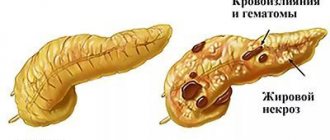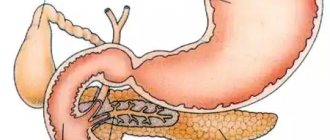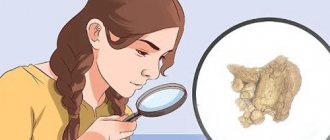Pancreatitis is an acute or chronic inflammation of the pancreas tissue with subsequent disruption of the secretory and endocrine functions of the organ. Most often, the development of pathology is associated with systematic consumption of large amounts of alcohol, smoking, and cholelithiasis.
During an exacerbation of pancreatitis, a person experiences prolonged intense pain in the upper half of the abdomen, his digestion process is disrupted, and yellowness of the skin and mucous membranes may appear.
Treatment includes following a diet, taking medications to facilitate the digestion of food, and painkillers. In some cases, surgery may be required.
According to statistics, in general, the prevalence of the disease does not depend on gender. However, acute alcoholic pancreatitis occurs more often in men, which is associated with a greater addiction to alcoholic beverages among this population group. The disease mainly affects people of working age from 30 to 50 years. In women, the development of pancreatitis is more often caused by gallstone disease.
Causes
The disease can be caused by toxic effects, autoimmune processes, have a hereditary predisposition, or become a complication of gallstone disease.
Alcohol abuse, smoking and obstruction of the bile ducts with gallstones are the most common causes of pancreatitis. In the latter case, the outflow of digestive secretion from the pancreas into the duodenum is disrupted, which leads to its stagnation and “self-digestion” of the organ. The breakdown products of ethyl alcohol have a direct toxic effect on pancreatic cells, as do a number of drugs (estrogens, sulfonamides, tetracycline, erythromycin, thiazides, mercaptopurine). In addition, systematic alcohol abuse is accompanied by thickening of bile, which predisposes to impaired patency of the bile ducts. Nicotine addiction also predisposes to the development of the disease, as it affects the cardiovascular system, causing narrowing of the lumen of blood vessels and a decrease in blood flow to organs.
Damage to the pancreas is also associated with heredity, in particular, it can be genetically determined or caused by congenital developmental anomalies. Autoimmune pancreatitis occurs both alone and in combination with Sjogren's syndrome, inflammatory processes in the intestines and many other autoimmune disorders.
Symptoms
Clinical manifestations of the disease are associated not only with damage to the organ itself, but also with a violation of its secretory and endocrine functions. In acute pancreatitis, the symptoms are pronounced:
- Intense pain in the epigastric region, left hypochondrium, local or encircling, often radiating under the left shoulder blade. Unpleasant sensations intensify when lying down and after an error in diet.
- Increased salivation, belching, nausea, frequent vomiting, which does not bring relief.
- Increased body temperature. Fever and chills may occur.
- Changes in skin and mucous color. Moisture and pallor of the skin and moderate yellowing of the sclera are often observed. In rare cases, the skin also takes on a yellowish tint. There may be bluish spots on the body and hemorrhages in the navel area.
- Dyspeptic symptoms – bloating, heartburn.
- Irritability, tearfulness, and in severe cases pancreatogenic psychosis develops.
Chronic pancreatitis is characterized by periods of exacerbation and remission and has a staged course.
In the preclinical stage, there are no symptoms of the disease; changes in the pancreas become an accidental finding during an ultrasound of the abdominal organs. During the period of initial manifestations, multiple episodes of exacerbation of pancreatitis are observed with manifestations characteristic of the acute form of the disease. Gradually, their frequency becomes lower, but symptoms persist during the interictal period: abdominal pain, occasional vomiting, nausea, diarrhea, flatulence. At the stage of persistent symptoms, there is pain in the upper half of the abdomen, often of a girdling nature. The patient loses weight, in particular due to refusal to eat due to fear of increased pain. Manifestations of secretory and endocrine insufficiency, such as indigestion and hyperglycemia, intensify.
Subsequently, pancreatic atrophy occurs. The pain may become less intense or absent, and the frequency of attacks of pancreatitis is reduced. The feces become mushy, foul-smelling, and greasy. Exhaustion is observed, and pancreatogenic diabetes mellitus develops. In the last stage, systemic complications arise, and malignant degeneration of the tissue of the affected organ is possible.
When are tests taken?
As soon as the first signs of disruption of the normal functioning of the pancreas begin to appear, you should immediately go to see an experienced specialist. A gastroenterologist or therapist will prescribe a basic examination, after which, in accordance with the results obtained, he will refer for additional studies. Analyzes are taken for the following indicators:
- increased salivation;
- vomiting state;
- frequent belching of air or food;
- decreased appetite;
- increased gas formation;
- diarrhea (feces are yellowish or straw-colored, with a sharply unpleasant odor, sometimes containing particles of undigested food);
- weight loss;
- the body gets tired quickly.
The above conditions of the body indicate poor functioning of the pancreas, which affects well-being, impairs the ability to work, the skin becomes dry, hair falls out, and anemia develops. The main thing is to promptly identify the pathology and begin treatment. Severe exhaustion, electrolyte imbalance and loss of vital microelements can be life-threatening.
You should also know that before taking tests for chronic pancreatitis, eating is prohibited, and a few days before this you should avoid fatty and fried foods. If tests need to be taken to determine glucose levels, then you can eat food as usual, without limiting yourself.
Complications
Depending on the form, severity and stage of the disease, the risk of developing certain complications of pancreatitis increases.
With a progressive long-term course of the pathology, disturbances in the outflow of bile with subsequent obstructive jaundice, the formation of an abscess, cysts, the development of portal hypertension, pancreatogenic diabetes mellitus, parapancreatitis, “enzymatic” cholecystitis, pneumonia, exudative pleurisy, paranephritis, and pancreatic cancer are possible. The consequences of an acute process can be:
- peritonitis;
- septic phlegmon of retroperitoneal tissue;
- arrosive bleeding in the digestive tract, hemorrhage into the abdominal cavity;
- obstructive jaundice;
- ascites;
- formation of internal and external digestive fistulas, abscesses and infiltrates.
In severe cases, shock and multiple organ failure with a high risk of death may develop.
Diagnostics
The identification and treatment of pancreatitis is carried out by a general practitioner and gastroenterologist together with an endocrinologist, surgeon and other specialists.
Often, patients with an acute form of the disease are taken by emergency medical care to a surgical hospital, where a differential diagnosis of pancreatic damage with acute appendicitis, cholecystitis and other pathologies is carried out. After clarifying the complaints, collecting an anamnesis, including dietary patterns, bad habits, frequency of relapses, concomitant diseases of the biliary system, and examination, the doctor refers the patient for tests, as well as instrumental studies.
As part of the laboratory examination of the patient, the following is carried out:
- General clinical blood test. There are signs of inflammation: acceleration of ESR, leukocytosis.
- Biochemistry of blood. Damage to the pancreas during pancreatitis is characterized by increased activity of enzymes (amylase, lipase), possible hyperglycemia, hypoalbuminemia and hypocalcemia, bilirubinemia, as well as increased activity of liver enzymes (ALT, AST, transaminases), CRP.
- Biochemical examination of urine. It is carried out to determine amylase activity in urine.
- Coprogram. Steatorrhea is characteristic.
- Determination of pancreatic elastase in feces.
Instrumental diagnosis of pancreatitis includes:
- Ultrasound of the abdominal organs is a method of visualizing the gland itself and surrounding organs;
- SCT and MRI of internal organs to obtain more detailed information about anatomical changes in them;
- endoscopic retrograde cholangiopancreatography for the purpose of visualizing the lumen of the ducts, taking pancreatic secretions, removing stones;
- endoscopic elastography of the pancreas - allows you to determine the rigidity and rigidity of the tissue, assess the degree of its connective tissue replacement and the secretory function of the organ;
- esophagogastroduodenoscopy to assess the condition of the hollow digestive organs.
Severity of chronic pancreatitis
There are three degrees of severity of chronic pancreatitis:
Mild degree
- exacerbations are rare (1-2 times a year), short-lived
- moderate pain
- no weight loss
- no diarrhea, no fatty stools
- Coprological examination of stool is normal (no neutral fat, fatty acids, soaps)
With mild severity of chronic pancreatitis, long courses of medication are usually not required, since lifestyle changes and giving up bad habits often prevent relapses.
Average degree
- exacerbations 3-4 times a year, occur with prolonged pain syndrome
- There may be an increase in amylase and lipase in the blood
- periodic loose stools, greasy stools
- there are changes in the coprogram
With moderate severity of chronic pancreatitis, a strict diet, longer courses of therapy, and constant supervision by the attending physician are necessary.
Serious condition
- frequent and prolonged exacerbations with severe, prolonged pain syndrome
- frequent loose stools, fatty stools
- loss of body weight, up to exhaustion
- complications (diabetes mellitus, pseudocysts, etc.)
In severe cases of chronic pancreatitis, constant maintenance therapy, stronger medications and a strict diet are required. Often, patients need careful monitoring not only by a gastroenterologist, but also by doctors of other specialties (endocrinologist, surgeon, nutritionist). Emerging exacerbations, as well as complications of the disease, pose a threat to the patient’s life and, as a rule, are an indication for hospitalization.
The presence of chronic pancreatitis, regardless of severity, requires immediate consultation with a doctor, since without treatment and lifestyle changes, the process will steadily progress.
Treatment
You should seek medical help at the first signs of pancreatitis, then the chance of avoiding complications and the disease becoming chronic will be higher.
During an exacerbation of the disease, fasting is recommended. All patients suffering from pancreatitis must follow a diet and give up alcohol and smoking. During the interictal period, you should eat small portions several times a day, including in your diet mainly foods high in proteins and complex carbohydrates, dietary fiber, and vitamins.
Drug therapy involves taking drugs from the following groups:
- analgesics for pain relief in pancreatitis;
- pancreatic enzymes;
- inhibitors of hydrochloric acid secretion in the stomach;
- sedatives and antidepressants;
- antibiotics;
- insulin;
- vitamins
In case of complicated course of the disease, as well as in some cases of acute abdominal pain, endoscopic or surgical intervention is indicated.
Prevention
Primary prevention of pancreatitis is to avoid alcohol, eat a variety of foods that are low in fat, saturated fat and cholesterol, include grains, vegetables and fruits in the diet, and stop smoking.
Acute pancreatitis can develop not only in people who regularly abuse alcohol, but also as a result of a single intake of alcohol-containing drinks with a fatty, fried and spicy snack in large quantities. Small, proper nutrition for pancreatitis serves to prevent exacerbations of its chronic form.
Stool analysis
In some cases, if individual symptoms of inflammation appear, you will need to undergo an examination of the composition and structure of stool. To obtain a correct and reliable result, you will have to maintain a diet for a certain time. You need to consume 105 g of protein, 180 carbohydrate and 135 fatty foods. This will help provide accurate information regarding the functioning of the pancreas.
An increased content of fats and fatty acids in the stool indicates a lack of lipase. You can often find undigested pieces of food in the structure. Among other indicators, a decrease in the amount of elastase stands out.








